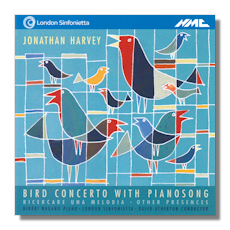
The Internet's Premier Classical Music Source
Related Links
- Latest Reviews
- More Reviews
-
By Composer
-
Collections
DVD & Blu-ray
Books
Concert Reviews
Articles/Interviews
Software
Audio
Search Amazon
Recommended Links
Site News
 CD Review
CD Review
Jonathan Harvey

Bird Concerto with Pianosong
- Bird Concerto with Pianosong 1
- Ricercare una melodia for oboe 2
- Other Presences 3
- Ricercare una melodia for cello 4
1 Hideki Nagano, piano
2 Gareth Hulse, oboe
2,3,4 Sound Intermedia, electronics
3 Paul Archibald, trumpet
4 Tim Gill, cello
1 London Sinfonietta/David Atherton
NMC D177
It's frankly a little unusual, and always pleasing, to encounter something entirely new, fresh and of undoubtedly high quality in contemporary composition where electronics and "traditional" instrumentation are involved. British composer Jonathan Harvey (born in 1939) has certainly achieved something substantially special on this latest release from NMC of which Bird Concerto with Pianosong is the lengthiest and weightiest piece. Harvey took what he took from spectralism (particularly from Grisey and Murail) and moved on. Yet strong traces of that movement's determination to elaborate a new "grammar" of music fusing natural sounds with more conventionally musical ones, and electronics, remain in the works on this CD. It's an important and stimulating disk that should be investigated by anyone truly concerned to stay abreast of the more significant and ground-breaking currents in the field.
Bird Concerto with Pianosong is not so lyrical as are such recent works by Harvey as Ashes Dance Back and Speakings. But it's every bit as unobtrusive, cautious, almost, every bit as tentative in conception and intention. Those elements (the composites of recorded birdsong and electronics) never approach experimentation for experimentation's sake. In other words, Harvey has written a piece (lasting a good half hour) which is quietly humble without failing to make an impression.
There is a subtext to Harvey's work here: he "stretches" (his term) birdsong into the human realm. This implies a wisdom that acknowledges the unity of nature and sits squarely with the composer's affinity with Eastern religious sensibility. Perhaps it also pays homage to what his teacher Messiaen, whose own love of birdsong is of course axiomatic, might has aspired to if the technical resources used with subtle yet striking effect here by Harvey had been available to the older composer, who died just ten years before Bird Concerto with Pianosong was written.
It's an unhurried piece. It takes its time for good reason. There are short passages reminiscent of other earlier works by Harvey notably the bells in Mortuos Plango, Vivos Voco (1980). What's more, Harvey's great skill is in rendering the disparate and at times seemingly disjointed material of Bird Concerto with Pianosong into a spectacularly successfully unified work. As with more conventional concerti, there is a perceptible structure… pace changes, tempi evolve, textures are built and transformed in accordance with a nice balance between the expected and the unnerving. The lasting effect is of listening to a major work with a highly vocal import where each phase anticipates, reflects and is relevant to those which surround it.
At the same time Harvey includes much concrete material: some 40 (Californian) birds can be heard here almost always heavily "treated", transformed again, always to some purpose. Although they do make personal appearances throughout; particularly at the start and end. The pianist (here Hideki Nagano) is responsible for operating the synthesizer on top of the piano where the score is usually placed. As with the other three pieces on the CD, the London Sinfonietta and soloists Gareth Hulse, oboe, in the version of Ricercare una melodia for that instrument [tr.2] and Tim Gill, cello, in that for his [tr.4] perform as though they'd known the pieces all their lives.
These musicians display a mixture of confidence, competence, technical certainty and quiet awe at what Harvey has created. That alone deserves to put this CD on your Holiday shopping list. Harvey has a way with instrumentation, the perception in his writing to elicit from each instrument just the tones and textures that make it interesting and striking. This is nowhere more evident than in Other Presences, where the strangely multi-timbral trumpet of Paul Archibald recalls Jericho, Handel and even marching bands.
Like the two Ricercare pieces, what strikes you in Harvey's immense resourcefulness, his command of his material, his creativity and determination to set musical bounds that really convey something worth communicating. Then meet his own vital expectations in every respect imaginable and many not without compromising either the immense energy, or obscuring individual building blocks of each of these works, each in their own way. It's one thing to "play" with sound and see what happens. It's another as so successfully happens here to define a worthwhile musical course and stick to it. What's so refreshing in the case of all the pieces on this CD (Ricercare una melodia was composed as long ago as 1984) is that Harvey makes the electronics work to the same profound and fruitful ends… the balance, tension and at times almost (but not quite) open-ended relationship between assertion and agitation: that mature complete lack of vanity on the composer's part once again.
The recording is close, focused and of course technically as accomplished (by Sound Intermedia) as it needs to be. The booklet, written by Arnold Whittall, is highly informative and provides just the right amount of information on the technicalities of each of the pieces on this very noteworthy CD. If you want an example of how what to the uninformed might seem like the cold and impersonal world of synthesized sound can evoke the utterly natural and human, this CD goes a long way towards providing you with one as well as containing much beautiful and original music that's obviously destined to last.
Copyright © 2011, Mark Sealey.















